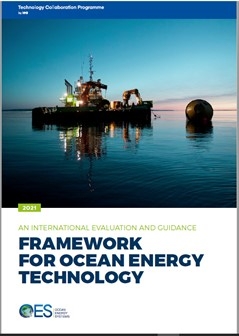
The IEA-OES releases “
An International Evaluation and Guidance Framework for Ocean Energy Technology” to respond to a need to have a completely objective evaluation of how a technology performs against key criteria. The information required to carry out a fully objective, quantitative evaluation is not always available, especially at the early stages of the development process. This means that the evaluation approach must evolve, taking in to account the development stage, activities completed and the available information.
This document is applicable to subsystems (e.g. power take-off, mooring and connection systems), devices (wave energy converters and tidal stream energy converters) and arrays of devices and is intended to be used by different stakeholders like developers, research organisations, standard institutions and private and public funding organisations.
This Task developed within the IEA-OES work programme has taken an iterative approach, engaging numerous stakeholders from across the ocean energy sector and building upon previous work. Beyond the release of this document, work will continue through engagement and collaboration with standards institutions, progressing towards a complete and internationally agreed process for maturation and evaluation of ocean energy technology.
The goal of this document is to accommodate formal standards and guidelines, where they already exist, and provide cues for the future production of other supporting standards and guidelines where required. Matthijs Soede, Vice-Chair of the IEA-OES ExCo said,
‘Beyond delivery of this document, OES will continue engagement and collaboration, progressing towards an internationally agreed process for maturation and evaluation of ocean energy technology. This Guidance framework is an important milestone.´
Jonathan Hodges, Senior Innovation Engineer from Wave Energy Scotland said, ‘
This document is a valuable step towards the concept of a ‘Technology Passport’, where innovative solutions can demonstrate pedigree by completing internationally agreed development stages. This facilitates improved international collaboration between funders and developers across the wave and tidal stream sectors.’
The report is available at:
https://www.ocean-energy-systems.org/publications/oes-documents/
Reference: Hodges J., Henderson J., Ruedy L., Soede M., Weber J., Ruiz-Minguela P., Jeffrey H., Bannon E., Holland M., Maciver R., Hume D., Villate J-L, Ramsey T., (2021) An International Evaluation and Guidance Framework for Ocean Energy Technology, IEA-OES

 The IEA-OES releases “An International Evaluation and Guidance Framework for Ocean Energy Technology” to respond to a need to have a completely objective evaluation of how a technology performs against key criteria. The information required to carry out a fully objective, quantitative evaluation is not always available, especially at the early stages of the development process. This means that the evaluation approach must evolve, taking in to account the development stage, activities completed and the available information.
The IEA-OES releases “An International Evaluation and Guidance Framework for Ocean Energy Technology” to respond to a need to have a completely objective evaluation of how a technology performs against key criteria. The information required to carry out a fully objective, quantitative evaluation is not always available, especially at the early stages of the development process. This means that the evaluation approach must evolve, taking in to account the development stage, activities completed and the available information.